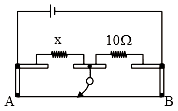The drift velocity of the electrons in a current-carrying metallic conductor is of the order of
1.
2.
3.
4.
धारावाही धात्विक चालक में इलेक्ट्रॉनों का अपवाह वेग किस कोटि का होता है?
1.
2.
3.
4.
A metallic block has no potential difference applied across it, then the mean velocity of free electron is (T = absolute temperature of the block) :
(1) Proportional to T
(2) Proportional to
(3) Zero
(4) Finite but independent of temperature
किसी धात्विक गुटके में कोई विभवांतर अनुप्रयुक्त नहीं है, तब मुक्त इलेक्ट्रॉन के माध्य वेग की गणना कीजिए (T= गुटके का परम ताप):
(1) T के अनुक्रमानुपाती
(2) के अनुक्रमानुपाती
(3) शून्य
(4) परिमित परन्तु ताप से स्वतंत्र
Five resistances are connected as shown in the figure. The effective resistance between the points A and B is :
(1)
(2)
(3) 15 Ω
(4) 6 Ω
पाँच प्रतिरोध आरेख में दर्शाए गए अनुसार जुड़े हुए हैं। बिंदुओं A और B के मध्य का प्रभावी प्रतिरोध है:
(1)
(2)
(3) 15 Ω
(4) 6 Ω
The potential difference across the 100Ω resistance in the following circuit is measured by a voltmeter of 900 Ω resistance. The percentage error made in reading the potential difference is :
(1)
(2) 0.1
(3) 1.0
(4) 10.0
दिये गए परिपथ में 100Ω प्रतिरोध के मध्य विभवांतर को 900 Ω प्रतिरोध के वोल्टमीटर से मापा जाता है। विभवांतर के पाठ्यांक में उत्पन्न प्रतिशत त्रुटि की गणना कीजिए:
(1)
(2) 0.1
(3) 1.0
(4) 10.0
In the circuit shown below, the cell has an e.m.f. of 10 V and internal resistance of 1 ohm. The other resistances are shown in the figure. The potential difference is :
(1) 6 V
(2) 4 V
(3) 2 V
(4) –2 V
निम्नवत् दर्शाए गए परिपथ में, सेल का विद्युत वाहक बल 10V है और आंतरिक प्रतिरोध 1ओम है। अन्य प्रतिरोध आरेख में दर्शाए गए हैं। के मध्य विभवांतर ज्ञात कीजिए:
(1) 6 V
(2) 4 V
(3) 2 V
(4) –2 V
In the given circuit, with a steady current, the potential drop across the capacitor must be :
(1) V
(2) V / 2
(3) V / 3
(4) 2V / 3
दिए गए परिपथ में, स्थायी धारा के साथ, संधारित्र के मध्य विभव पतन कितना होना चाहिए?
(1) V
(2) V / 2
(3) V / 3
(4) 2V / 3
A meter bridge is set up to determine unknown resistance x using a standard 10 resistor. The galvanometer shows the null point when the tapping key is at a 52 cm mark. End corrections are 1 cm and 2 cm respectively for end A and B. Then the value of x is

1. 10.2
2. 10.6
3. 10.8
3. 11.1
10 मानक प्रतिरोध का उपयोग करके अज्ञात प्रतिरोध x ज्ञात करने के लिए मीटर सेतु की स्थापना की गई है। जब दाब कुंजी 52cm के चिह्न पर होती है, तब धारामापी संतुलन बिंदु दर्शाता है। A और B के लिए अंत संशोधन क्रमशः 1cm और 2cm हैं। तब x के मान की गणना कीजिए-

1. 10.2
2. 10.6
3. 10.8
3. 11.1
The circuit shown in Fig. 7.33 contains a battery, a rheostat, and two identical lamps. What will happen to the brightness of the lamps if the resistance of the rheostat is increased?
Lamp P Lamp Q
a. Less bright Brighter
b. Less brighter Less brighter
c. Brighter Less brighter
d. No change Brighter
चित्र 7.33 में दर्शाए गए परिपथ में एक बैटरी, एक धारा-नियंत्रक और दो समान लैंप हैं। यदि धारा-नियंत्रक का प्रतिरोध बढ़ता है, तब लैंप की दीप्त कैसे प्रभावित होगी?
*Fig. 7.33 - चित्र 7.33
लैंप P लैंप Q
a. कम दीप्त दीप्त
b. कम दीप्त कम दीप्त
c. दीप्त कम दीप्त
d. अपरिवर्तित दीप्त
The figure shows a network of currents. The magnitude of currents is shown here. The current i will be
(1) 3 A
(2) 13 A
(3) 23 A
(4) – 3 A
आरेख धाराओं के तंत्र को दर्शाता हैं। धाराओं का परिमाण यहां दर्शाया गया हैं। धारा i का मान क्या होगा?
(1) 3 A
(2) 13 A
(3) 23 A
(4) – 3 A
In the circuit in Fig. 7.27, bulb B does not glow although ammeter A indicates that the current is flowing. Why does the bulb not glow?
(1) The bulb is fused.
(2) There is a break in the circuit between bulb and ammeter.
(3) The variable resistor has too large resistance.
(4) There is a break in the circuit between the bulb and the variable resistance.
आरेख 7.27 में परिपथ में, बल्ब B दीप्त नहीं होता है, जबकि ऐमीटर A यह दर्शाता है कि धारा प्रवाहित हो रही है। बल्ब दीप्त क्यों नहीं होता है?
*Variable resistor - परिवर्ती प्रतिरोधक
*Switch - स्विच
*Battery - बैटरी
*Fig. 7.27 - आरेख 7.27
(1) बल्ब फ्यूज़ हो गया है।
(2) बल्ब और एमीटर के मध्य परिपथ भंजन में है।
(3) परिवर्ती प्रतिरोधक का प्रतिरोध बहुत उच्च है।
(4) बल्ब और परिवर्ती प्रतिरोधक के मध्य परिपथ भंजन में है।















